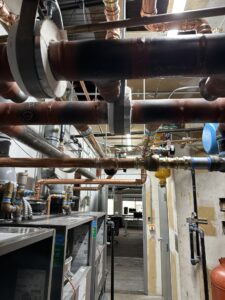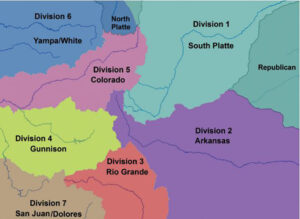A typically designed and/or installed detail for a heating water system (and hydronic systems in general) shows the makeup water with a permanent hard connection to the heating water system. The EV Studio Mechanical Department recommends against this practice, however.
There are a few reasons for this. Even if an isolation valve is provided to isolate the makeup water from the heating water unless it is manually opened, this valve can easily be left open. This introduces makeup water to the heating water system automatically and has the potential to create a serious problem. If for some reason the heating water system suffers a severe leak or break in which a significant amount of its water is drained in a short period of time, a permanent hard connection can then begin introducing a large amount of cold water to the system as it tries to compensate for the leak. If this were to happen when the boilers in the heating water system were firing and hot, then cold water could be introduced to a hot boiler. Hot boilers can react badly to having cold water dumped in them. This cold water basically flashes into steam, and in the process, expands greatly in a very short period of time. This could cause loud knocking or hammering in the boiler, or in the worst case, the boiler could explode. It isn’t hard to imagine the potential for loss of property or life and the associated legal ramifications that could result from a boiler exploding. Even if your heating water system never springs a leak big enough to require a great deal of water to be introduced into the system and cause a boiler to make scary noises (and believe me, unexpected loud noises coming from boilers are scary if you’re standing right next to them) a permanent hard connection of makeup water to the heating water system can mask small leaks. If the water lost due to a small leak is automatically replenished, it may go unnoticed and unrepaired. A permanent hard connection of makeup water can also introduce air into the system. Permanent connections could also have the potential to dilute an antifreeze solution. If this dilution were to happen to a heating water system that has exposure to freezing temperatures and the water in the pipes froze and caused a break in the line large enough to drain a significant amount of water from the system, then we’ve created the unfavorable conditions described above.
To avoid all of this, the EVstudio Mechanical Department recommends that a makeup water line be brought into the boiler room and provided with a backflow preventer, pressure reducing valve, isolation valve, and threaded hose end. A pipe branch can then be provided on the heating water system with its own isolation valve and hose end. Then, when there is ever a need to provide makeup water to the system, the makeup line can be connected to the heating water system with a hose. Water can then be introduced in this manner without a permanent hard connection and hopefully avoid a bit of potentially serious trouble.









